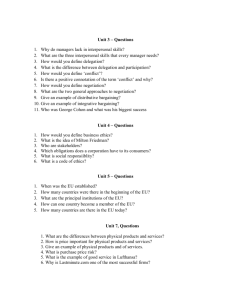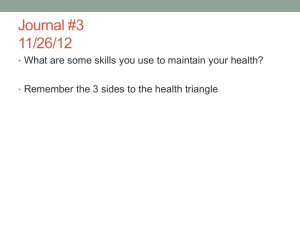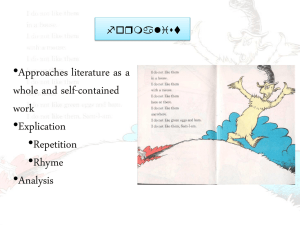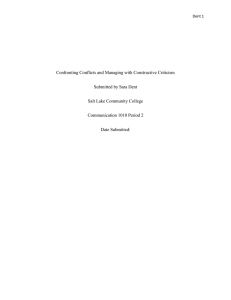Embossed PPT
advertisement
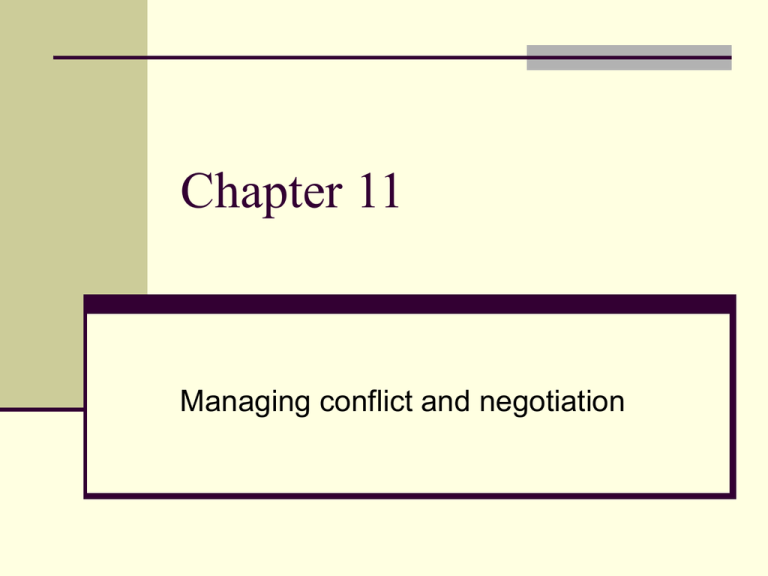
Chapter 11 Managing conflict and negotiation Conflict and Negotiations - Key Concepts Conflict: definition Constructive and Destructive aspects Levels of conflict Stages of conflict Indirect and direct conflict mgmt approaches Conflict styles/behaviors Negotiation Hard & soft bargaining, ethical conflict behaviors Coping with Criticism Conflict Conflict is____________________ Substantive A fundamental disagreement over ends or goals to be pursued and the means for their accomplishment. Emotional Interpersonal difficulties that arise over feelings of anger, mistrust, fear, and resentment. Constructive (Functional) Conflict Helps identify issues and underlying problems Acts as a safety valve, releasing tension and anger Encourages interaction and involvement Promotes creativity Facilitates problem solving Promotes sharing of information Tests strength of ideas - under fire Adapted from Gary L. Kreps, Organizational Communication, 1986, p. 188-189 Destructive (Dysfunctional) conflict Results in negative outcomes Decreases work productivity and job satisfaction Increases in absenteeism and turnover A successful leader will be alert to destructive conflicts and take action Levels of conflict Intrapersonal Interpersonal Intra-group Inter-group Organizational Levels of Conflict Intrapersonal Level Involve actual or perceived pressures from incompatible goals or expectations within a person One’s perceptions differ from others; one’s judgment called into question Approach- Approach Conflict Choices: two positive and equally attractive alternatives Example: two jobs = equally positive duties, pay, benefits, location Levels of Conflict, cont. Intrapersonal Level Approach- Avoidance Conflict Choice: something has both positive and negative consequences Example: a great job in a lousy location Avoidance – Avoidance Conflict Choices: two negative and equally unattractive alternatives Example: two jobs - neither first choice in terms of duties, pay, location Levels of Conflict Interpersonal between two or more individuals Intergroup among and between groups Interorganizational related to competition and rivalry that characterizes firms operating in the same markets Diagnosing Conflict Vertical conflict: between hierarchical levels Supervisor –subordinate disagreements over resources, goals, deadlines, or performance Horizontal conflict: same level (coworkers, line - staff, functional units) Goal incompatibilities; ambiguities, Perceived resource scarcities Power or value differences or interpersonal factors Stages of Conflict Antecedent conditions Perceived and felt conflict Manifest conflict Conflict resolution, management or suppression Conflict aftermath Proposed by Louis Pondy (1967) Desired Outcomes Agreement Fair and equitable Stronger relationships Bridges of trust and goodwill for future Learning Greater self-awareness and creative problem solving Dean Tjosvold’s cooperative conflict model The Conflict Process Stage I Potential opposition Stage II Cognition and personalization Stage III Behavior Perceived conflict Antecedent conditions •communication •structure •personal variables Stage IV Outcomes Increased performance Manifest conflict Conflict Aftermath Decreased performance Felt conflict Conflict-handling Behaviors/styles: •competition •collaboration •accommodation •avoidance •compromise Indirect Conflict Management Approaches Reduce Interdependence Reduce required contact, build buffers, assign formal liaison Appeal to common goals Establish a common, overarching goal, ensure parties take responsibility Use chain of command Refer problem to more senior employees/managers Redesign the organization Rewrite scripts, rituals Conflict Styles/Behaviors (from K Thomas, 1976 and Rahim, 1985) High (Assertive) Dominating (competing) Integrating (collaborating) Compromising (Sharing) Concern for Self Avoiding (neglecting) Obliging (accommodating) Low (Unassertive) Low (Uncooperative) Concern for Others High (Cooperative) Direct Conflict Management Techniques Lose-lose Avoidance Sidestep, postpone, withdraw Accommodation Play down differences and highlight similarities; yield, obey or sacrifice to other Compromise Split the difference, exchange concessions, seek the middle-ground Direct Conflict Management Techniques Win-lose Competition: one party achieves its desires at the expense and to the exclusion of the other party’s desires Stand for your rights; defend your position which you believe is correct Direct Conflict Management Techniques Win-win Collaboration: Achieve each other’s goals Acceptable by both parties Establishes a process whereby all parties involved feel a responsibility to be open and honest about facts and feelings Explore the disagreement to learn from each other Results in problem solving or situation improvement Negotiation Process of making joint decisions when the parties involved have different preferences Successful negotiations: Substantive goals Concerned with outcomes relative to the “content” issues at hand Relational goals Concerned with outcomes relating to how well people involved in the negotiation, and any constituencies they may represent, are able to work with one another once the process is concluded Distributive Negotiating Hard Bargaining When each party holds out to get its own way Leads to competition Soft Bargaining When one party is willing to make concessions to the other to end the impasse Leads to accommodation Staking Out the Bargaining Zone Party A’s aspiration range Party B’s aspiration range Settlement range Party A’s target point Party B’s resistance point Party A’s resistance point Party B’s target point Integrative Negotiating Principled negotiations Negotiations based on the “merits” of the situation Foundations for gaining integrative agreements Be willing to trust the other Be willing to share information Be willing to ask concrete questions Ethical Conflict Behaviors Argue the specific issue at hand Focus on interests not positions Avoid dirty fighting (character attacks, slander, overly aggressive tactics) Separate the problem from the people Construct a “reasonable” argument Be open to alternate perspectives Avoid premature judgments Listen actively and evaluate fairly Judge using objective criteria Adapted from Kreps, 1986, Organizational Communication, p.189. And Schermerhorn Coping with Criticism Based on work by Ronald Adler and Gregg Walker (OSU) osu.orst.edu/instruct/comm440-540/ criticism.htm Constructive Criticism The generation of evaluative comments Can promote constructive growth in individuals and relationships Guidelines for the Critic Understand why you are offering criticism Try to understand the other person Describe the behavior, not the person Focus on specifics and the “here and now”, not generalities or the past Emphasize your feelings Invite a collaborative discussion to solve the problem Allow the other person to make decisions When Criticized ... Recognize and welcome the value of constructive criticism Listen actively, with an open mind Paraphrase what the other is saying Try to understand the other’s perspective Work hard to avoid becoming defensive Maintain your own power and authority to make decisions Communicate clearly how you feel and think Insist on valid criticism Ask for Specifics Ask for specifics: What is the specific behavior (s) that bothers this person? In what circumstances does the objectionable behavior occur? Does this criticism also involve others? Ask About Consequences .. Ask about the consequences of your behavior: What need of theirs is not being met? What negative consequences have occurred as a result of this behavior? Resolution Make sure you understand the original complaint or problem Take time and make the effort to hear out the other person completely Ask how s/he would suggest the issue be resolved Provide feedback on your point of view and how you plan to proceed only after completing the previous 3 steps

